
The Project Gutenberg EBook of Decorative Art of Indian Tribes of Connecticut, by Frank Gouldsmith Speck This eBook is for the use of anyone anywhere at no cost and with almost no restrictions whatsoever. You may copy it, give it away or re-use it under the terms of the Project Gutenberg License included with this eBook or online at www.gutenberg.org Title: Decorative Art of Indian Tribes of Connecticut Author: Frank Gouldsmith Speck Release Date: August 13, 2014 [EBook #46578] Language: English Character set encoding: ISO-8859-1 *** START OF THIS PROJECT GUTENBERG EBOOK DEC. ART--INDIAN TRIBES--CONNECTICUT *** Produced by Reiner Ruf, Greg Bergquist and the Online Distributed Proofreading Team at http://www.pgdp.net (This file was produced from images generously made available by The Internet Archive/American Libraries.)
Original Book Cover
CANADA
DEPARTMENT OF MINES
Hon. Louis Coderre, Minister; R. G. McConnell, Deputy Minister.
GEOLOGICAL SURVEY
MEMOIR 75
No. 10, Anthropological Series
BY
Frank G. Speck
OTTAWA
Government Printing Bureau
1915
No. 1499
| PAGE | |||
| Figure | 1. | Mohegan basket gauge. | 11 |
| “ | 2. | Mohegan hand splint planer. | 11 |
| “ | 3. | Mohegan crooked knives with wood and antler handles. | 13 |
| “ | 4. | Bone punch. | 15 |
| “ | 5. | Typical basketry design of the Mohegans. | 15 |
| “ | 6. | Mohegan and Niantic painted designs. c, f, from specimen b, Pl. IV, Niantic. a, d, from specimen a, Pl. III, Mohegan. b, e, from specimen b, Pl. I, Mohegan. |
17 |
| “ | 7. |
Mohegan and Niantic painted designs. a, from specimen a, Pl. III, Mohegan. b, from specimen b, Pl. IV, Niantic. c, e, from specimen b, Pl. I, Mohegan. d, from specimen a, Pl. I, Mohegan. f, from specimen c, Pl. II, Mohegan. |
19 |
| “ | 8. |
Mohegan and Niantic painted designs. a, c, d, e, f, from specimen b, Pl. IV, Niantic. b, from specimen a, Pl. III, Mohegan. |
21 |
| “ | 9. |
Mohegan painted designs. a, c, from specimen a, Pl. III, Mohegan. b, Mohegan. |
23 |
| “ | 10. |
Mohegan, Niantic, and Scatticook painted designs. a, b, from specimen a, Pl. III, Mohegan. c, e, f, g, h, i, k, from specimen b, Pl. IV, Niantic. d, from specimen a, Pl. II, Mohegan. j, from specimen c, Pl. II, Mohegan. l, from Curtis, Scatticook. |
25 |
| “ | 11. |
Mohegan and Niantic painted designs. a, from specimen b, Pl. I, Mohegan. b, c, d, e, f, from specimen b, Pl. IV, Niantic. |
27 |
| “ | 12. |
Mohegan, Scatticook, and Niantic painted designs. a, c, from specimen (Mohegan). b, from specimen a, Pl. III, Mohegan. d, f, from Curtis (Scatticook). e, from specimen b, Pl. IV, Niantic. |
29 |
| “ | 13. | Linear border designs from Mohegan painted baskets. | 29 |
| “ | 14. |
Body designs from Mohegan painted baskets. a, on the top of the basket; b on the sides. |
31 |
| “ | 15. | The curlicue or roll, in Scatticook baskets. | 33 |
| “ | 16. | The curlicue or roll, in Scatticook baskets. | 35 |
| “ | 17. | Bottom of Scatticook basket, showing trimming of radial splints. | 37 |
| “ | 18. | (a) Scatticook gauge. | 39 |
| (b) Scatticook gauge. | 39 | ||
| “ | 19. | Scatticook gauges. | 41 |
| “ | 20. | Scatticook splint planer. | 43 |
| “ | 21. | Mohegan beadwork on birch bark. | 43 |
| “ | 22. | Carved bone hand. | 43 |
| “ | 23. | Decorated Mohegan wooden object. | 45 |
| Plate | I. | Mohegan baskets (a and b painted). | 49 |
| “ | II. | Mohegan baskets (a, b, and c painted). | 51 |
| “ | III. |
Mohegan baskets. a—Painted. b—Shows bottom construction. |
53 |
| “ | IV. |
Niantic and Mohegan baskets. a—Mohegan washing basket, b—Niantic storage basket made about 1840 by Mrs.Mathews at Black Point (near Lyme, Conn.) |
55 |
| “ | V. | Mohegan carrying baskets. | 57 |
| “ | VI. | Mohegan baskets, fancy work baskets, and wall pocket. | 59 |
| “ | VII. | Tunxis baskets. Made by Pually Mossuck, a Tunxis woman from Farmington, Conn., who died about 1890 at Mohegan. Lower left hand basket slightly painted. | 61 |
| “ | VIII. | Scatticook baskets, made by Rachel Mawee, Abigail Mawee, and Viney Carter, who died at Kent, Conn. about 1895. | 63 |
| “ | IX. | Oneida stamped basket (Heye collection). | 65 |
| “ | X. |
Mohegan and Niantic moccasins. a—Mohegan moccasins. b—Niantic moccasins from the old reservation at Black Point, near Lyme, Conn. |
67 |
| “ | XI. | Mohegan and Niantic beaded bags (3 from the Heye collection). | 69 |
| “ | XII. | Mohegan corn mortars and stone pestle. | 71 |
| “ | XIII. | Mohegan ladles and spoons. | 73 |
A fortunate phase of the research work among the Indians of New England has recently led to the extension of our knowledge of the decorative art of the eastern Algonkin tribes. This has been made possible by the discovery of specimens, and by information furnished by several aged Indians of the Mohegan and Niantic tribes of eastern Connecticut.[1]
During several visits in the winter of 1912–13, Mrs. Henry Mathews (Mercy Nonsuch), the only full-blooded survivor of the Niantic Indians, formerly inhabiting the shore of Long Island sound around the mouth of Niantic river, and the Mohegans, Cynthia Fowler, Charles Mathews, and the late Fidelia Fielding, the last person who could speak the Mohegan language, all contributed towards the material here presented.[2]
The principal field of decoration among the Mohegan and Niantic, so far as we can now tell, seems to have been chiefly in paintings on baskets. Decorative wood-carving upon household utensils and sometimes upon implements was also quite common. Bead-work, on the other hand, appears to have been a secondary activity. A short account of the basket-making itself is required, before the basket decorations are described. For household and gardening purposes these people have developed a few types[Pg 2] of baskets (manu·´da[3] “receptacle”) varying in shape, size, and weave. The most characteristic forms seem to have been rectangular baskets a foot or so in length, two-thirds as high, and of proportionate width, and without handles, though often provided with covers. These are the household storage articles (Plates I and II). For carrying garden products, and for hand use in general, are somewhat smaller round-bottomed baskets, with handles or bails, ranging in width from 4 inches up to baskets with a capacity of half a bushel (Plates III and V). Then we have the type known, among the Indians from Nova Scotia to the Southern States, as “melon”, “rib”, or “gizzard” baskets (Plate III, upper right hand corner), provided with bails, and also used for carrying. And, lastly, there are the open work baskets, some of which are small fancy articles, while others are used as strainers (Plates IV and VI). These fall under the general type of open hexagonal twill baskets. All these types, of course, are commonly found among practically all the tribes of the Atlantic coast, varying only in the minor details of weave at the rim and the bottom.
As to the materials, the Mohegan and Niantic, like the northern New England tribes, used prepared splints of the brown ash. Next in importance is the white oak. Here the pounding is unnecessary, the splints being more easily freed from the log. Swamp maple is also commonly used by the Mohegan basket-makers, although it is not as durable as either the oak or the ash.
All these materials go through the same processes of preparation before the splints are ready to be woven. The first stage in the process consisted in pounding the ash log all over, and then separating the layers of wood. Next, the lengths of splints were shaved smooth with a spoke-shave, which looks like a European tool. Hand gauges were then used to cut the splints into strips of uniform width. These gauges (Figure 1), not unlike those of the Penobscots, were provided with teeth made,[Pg 3] in recent days, of clock springs; the width of the splint depending upon the distance at which the teeth were set in the end of the gauge. Another small implement, a sort of hand planer through which the splint was drawn to make it finer, was also obtained at the Mohegan village (Figure 2). The knives of the crooked type, bən·ī·´dwaŋg (Figure 3), used by the Mohegans for woodworking in general, have a very pronounced curve, and are usually mounted on wooden or sometimes buckhorn handles. While not necessarily used directly in basket making, these knives are indispensable to the Indian workman. A very old bone pointed tool, probably a punch (Figure 4), seems to have been used in some way, perhaps in weaving the basket rims.
The ordinary weave among these tribes is the common checker-work. The basket bottoms are of two kinds, rectangular and round. In the rectangular bottoms the checker-work forms a foundation, the same process continuing up the sides. In the round-bottomed forms the splints are arranged like the spokes of a wheel crossing and radiating from a centre. These splints turn upwards around the bottom, and form the standards around which the side filling is woven, in the under-one-over-one-process. Among the Mohegans a certain feature of the round-bottomed types occurs which has not yet been found in other tribes making similar baskets; that is, the broad flattened centre standards of the bottom, appearing in Plate III, figure b. The ordinary New England oak or maple hoops, one inside and the other outside, bound down by a splint in the ordinary manner of wrapping, constitute the rims of all the baskets. The second type of round baskets is called “gizzard” basket by the Mohegans (Plate III, upper right hand corner). These are generally made of oak, and their weave, although shown plainly in the illustration, is almost impossible to describe.
The decorations upon baskets are produced in two ways, either by running variously coloured splints into the weaving as fillers round the sides, or by painting with pigment upon broad splints various patterns extremely free in outline and quite independent of the technique. It is with such painted designs that we have chiefly to deal, because they perpetuate the native decorative art of these Indians. The colours appearing[Pg 4] upon the baskets are red (skwa´yo), black (sug·a´yo), and indigo (zi·wamba´yo), the commonest being red and black. The red is obtained by boiling down cranberries. The black dye has now been forgotten, although some think that it was either ‘snakeberries’ (or ‘poke-berries,’ termed skuk), or perhaps huckleberries. In later times they have used either water colours or blueing. The colours were applied by means of crude brushes, made by fraying the end of a splinter of wood, or by using a stamp cut from a potato, which is dipped into the colouring matter and then stamped on the splints.
The designs themselves in the field of basketry decoration are pre-eminently floral, the figures being highly conventionalized. The main parts of the blossom are pictured. The corolla of the flower forms the centre, surrounded by four petals, and commonly augmented by four corner sprays apparently representing the calyx from underneath brought into view. There is a fundamental similarity in these pseudo-realistic representations occurring on all the different baskets, which shows that this was the prevailing motive in this kind of decoration. The corolla usually occupies the exposed surface of one splint, and the four petals occupy the surrounding ones, as is shown in the natural size illustration (Figure 5). The colours in this specimen are limited to blue and red. Cynthia Fowler, a Mohegan informant, named the flower the “blue gentian”; but how generally this name was used in former times it is impossible to say. These flowers are usually found enclosed within a larger diamond-shaped space, on one side of the basket, the enclosing border consisting of a straight line or chain-like line edged by dots. These dotted borders and the flower elements are very characteristic of Mohegan and Niantic work. The corners of the baskets from top to bottom also constitute another favourite field of ornamentation. Here vertical alternating chain-like curves of several types appear. Examples of the available designs of both sorts are shown in Figures 6 to 14. The solid black in the sketches represents either black or dark indigo of the actual design; the lined spaces represent red.
Turning to the design reproductions (Figures 6, 7, 8, 9), we observe a most consistent similarity in all those of the rosette[Pg 5] type, to wit, the conventional centre, the radiating petals, and the enclosing diamond or four-curve, recurring with modifications in practically all of such designs. Some are very handsome, a few rather colourless. The dotting is very distinctive. Next are the line or border patterns, which, although adapted to linear spaces, are characterized, like the rosettes, by intertwined lines, dots, and petals. Frequently different rosettes appear on each of the four sides of the same basket; and the sides are also occasionally quartered diagonally by one of the border or line patterns, and are thus divided into triangular areas, each containing a rosette. Unfortunately none of the painted figures show in the photographs, on account of their having become quite faint through age and wear.[4]
In this whole series of conventional painted patterns a general resemblance to northeastern Algonkin designs, as far north as the Naskapi of Labrador, is very noticeable. It is, moreover, quite likely that similar designs among the Narragansetts were referred to by Roger Williams when he wrote, “They also commonly paint these (skin garments, etc.) with varieties of formes and colours.”[5]
A further extension of the ubiquitous splint basketry of the New England tribes, and the decorative work connected therewith, is furnished by another Connecticut tribe—the Scatticook, of the Housatonic river, near Kent. Their art is especially interesting, because it has also just become extinct among their descendants here. As a tribe the Scatticook (Pisga´‛tiguk, ‘At the fork of the river’) were composed of exiled Pequots, Mohegans, and the remnants of western Connecticut tribes who formed a new unit in their new home.[6] Their type of culture was accordingly intermediate in some respects between the eastern Connecticut tribes and those of the Hudson river.
To judge from a vocabulary which I obtained at Scatticook about ten years ago, they had closer linguistic affinities with the Hudson River (Delaware) group.
Until ten years ago the native art of basketry was preserved by the Scatticooks, and some specimens were then collected during several visits. It was found recently, in another visit to the tribe, that the industry had become extinct; so our remarks are now based upon old specimens and implements in the possession of the Indians. The general character of Scatticook work is the same as that of the Mohegans. Instead of the maple, however, the Scatticook used white oak or brown ash. The method of preparing the splints was the same, as was also the case with the types of weaving (Plate VIII). In the round-bottom forms we notice the same flat radiating splints cut narrow at the edge, as figured before in dealing with Mohegan work. The Scatticook baskets are, as a whole, quite finely constructed of very thin splints. One somewhat distinctive feature is found here, namely, the very frequent use of the curlicue or roll as an ornamental feature. The curlicue consists of a splint run over one of the warp splints and twisted between two alternate standards, thus making a sort of twisted imbrication. The Scatticook, considering the embellishment as representing a shell, call it “a shell”; and they term the baskets with this feature “shell-baskets” (Figures 15, 16, 17).
Three modifications of this ornamentation are shown in Figures 15, 16, a and b; in Figure 16, a, the splint is twisted alternately between two rows of warp at a different level; in Figure 15, the splint is curled twice in a different direction, and forms a point; in Figure 16, b, the splint is twisted once between two parallel rows of warp. This is claimed by the Indians to be a native feature; and, since it is found in the oldest baskets from the region, there seems little doubt that it is aboriginal.
The Scatticook seem to have employed almost exclusively pokeberry juice to stain the basket splints dark blue. In none of the specimens made in recent times do we find the painting upon the splints, as is the case among the Mohegans. The only record of this kind of work from the Scatticook is found in an[Pg 7] article by W. S. Curtis,[7] describing a collection of old baskets obtained many years ago.
The gauges made by these people are somewhat distinctive (Figures 18 a and b, and 19). One of their characteristics is that the decorations are largely functional, the object in the maker’s mind evidently having been to provide a firm grip for the operator and at the same time to produce a decorative effect. This interesting feature is noticeable in the few specimens that were discovered on the reservation, and in several others in the possession of collectors. They are all highly prized by their possessors. In one case there seems to have been an attempt to portray a fish on the handle. Another instrument, a knife used in shaving the splints, is shown in Figure 20.
While we may assume that some influence upon the art of the Connecticut Indians resulted from contact with the Iroquois, there is nothing to show that the former had such symbolic associations in their designs as did the Iroquois.[8] The general similarity of the Connecticut Indian decorations to those of both the Iroquois and the northeastern Algonkins is really too ambiguous to permit a final decision as to their affinities. Aware of these uncertainties, I feel, however, that the evidence sustains the conclusion that the stamped and painted designs are original to the southern New England Indians, and that they spread from them to the Iroquois.
The occurrence of identical types of splint basketry and similar potato stamp decorations among the Oneida (Plate IX) and Onondaga,[9] might lead to the impression, were we to overlook resemblances with northern Algonkin designs, of an Iroquoian origin for the whole technique. In a recent visit, however, to the Cherokee of North Carolina, for the purpose of tracing relationships between northern and southern art motives,[Pg 8] nothing was discovered comparable to these northern types either in design or technique, although the eastern Cherokee are quite conservative. This naturally leaves the art of the southern New England tribes to be tentatively classified as a somewhat distinctive branch of the northern and eastern Algonkin field, with some outside affinities.
From information and sketches furnished by Dr. J. Alden Mason, based on studies and photographs which he made of New England baskets in the C. P. Wilcomb collection, Oakland, Cal., it seems that similar stamped splint baskets were found among the Indians as far as the Merrimac River valley in southeastern New Hampshire. Specimens in the collection referred to are supposed to have come from Union, Me., Lenox, Mass., Ipswich, Mass., and Herkimer, N.H. While not numerous enough to permit of discussion, the specimens from this eastern extension of the stamped or painted basket area show a type of design different from that of our southern New England tribes. The patterns are less elaborate. Although it is difficult to account for it, they seem to bear closer resemblances to the designs on Oneida baskets.
North of the southern New England culture sub-area, which appears to have terminated at the Merrimac river, splint basketry and painted designs were replaced by the birch bark basketry and etched designs characteristic of the art of the Wabanaki group.
A few examples of Mohegan and Niantic beadwork have survived the decay of Indian culture in New England. These miscellaneous articles are shown in Plates X and XI. They include moccasins, bags, and portions of costume. Whether they have all been actually made by Mohegans is not certain, except where indicated. One peculiarity of Mohegan art is beadwork upon birch bark. A couple of very old specimens (Figure 21) of this work have come to light. The foundation is the thin bark of the white birch. The beadwork figures are practically all floral, though a few geometrical designs occur; and realism appears as in the butterfly representation. The floral designs seem to be somewhat related to those found in the basket paintings, although they are not so aboriginal in appearance.[Pg 9] The beadwork designs are generally termed “forget-me-nots,” “daisies,” “yellow daisies,” with buds, leaves, and stems. It should be noted in this connexion that from the earliest time the Mohegans have had some contact with Iroquois, especially the Mohawks, who from time to time visited the Connecticut Indians in small parties. During the early nineteenth century a number of the latter joined the Iroquois, with whom an intermittent relationship has since been maintained. It may be said in general, however, that the same type of floral beadwork extends throughout the whole northeastern and Great Lakes area, in which the Mohegan work may be included. Almost identical bags, for example, both in form and design, come from the Mohegan, Penobscot, Malecite, Montagnais, and Ojibwa.
In the carving of wooden utensils, such as bowls, spoons, mortars, and miscellaneous articles, the Mohegans have shown considerable skill, as appears from what few articles have survived among them. Some of their bowls made from maple burls are exquisite. Several of these have been described and illustrated by Mr. Willoughby in a recent paper, the originals being in the Slater Memorial Museum, of Norwich. Wolf or dog faces facing inward from projections upon the rim are very well executed. Oftentimes such bowls were decorated by inserting wampum beads into the wood, giving the outline and eateries of the face. These bowls were used until a few generations ago for mixing native bread known as johnny-cake.
Hardly inferior in workmanship to the bowls are the very distinctive Mohegan mortars (də´kwaŋg, “pounder”) made of a pepperidge log, and provided with long stone pestles (gwu´nsnag, “long stone”). Three of these specimens, now in the Heye collection, are shown in Plate XII. Practically all of the large mortars for grinding corn in the household, among the Mohegans, were of this type. Their sides were tapered toward the pedestal, and there were from two to three handles on the sides near the bottom. Hollowed scallop work ornamented the edge of the pedestal. The mortars average about 17 inches in height; and their cavity, narrowing towards the bottom, is very deep. The stone pestle is 18 inches long. Until lately a few of these[Pg 10] heirlooms were cherished in several Mohegan families.
The use of wooden spoons and ladles (giya´mən) has not been entirely abandoned by these Indians. The designs of most of the forms are considered as aboriginal. They have rather broad oval—or sometimes even circular—bowls, sometimes flat-bottomed bowls; and the handles are of varying lengths, with rounded projections in the under side to prevent the ladle from sliding down into the pot. This favourite semi-decorative and functional feature also occurs in the handles of gauges (Figure 1). The spoons are usually made of birch or maple. One or two ornamentally carved specimens were found. One with a dog’s head at the end of the handle, and the bowl set at an angle to the handle, is in the Slater Museum. Another, recently obtained from the Indians (Plate XIII), has two human faces, back to back, at the end of the handle. The spoons range from 6 to 12 inches in length. Various types are shown in Plate XIII.
Several articles of bone, ornamentally carved, have come to light. Chief among these are whalebone canes, with skilfully made carvings. The handle of one of these canes represents a very natural looking human hand (Figure 22). This same figure has been met with in the carvings of the Penobscot and Iroquois.
A few miscellaneous articles made by old Mohegan workmen have been discovered during the investigation, one of which is covered with decorative designs (Figure 23). No discussion is warranted, since any possible interpretation has now been forgotten, even as to the function of the object.
Strange as it may seem to find definitive material amid such deculturated surroundings, there can be little doubt that these tribes have preserved designs of considerable antiquity. Perhaps they belong to an early type of eastern Algonkin art, consisting of curves, circles, ovals, wavy lines and dottings forming floral complexes, having a general distribution in the north and east, from which the more elaborate realistic floral figures of beadwork have developed.
Figure 1. Mohegan basket gauge.
Figure 2. Mohegan hand splint planer.
Figure 3. Mohegan crooked knives, with wood and antler handles.
Figure 4. Bone punch.
Figure 5. Typical basketry design of the Mohegans.
Figure 6. Mohegan and Niantic painted designs.
c, f, from specimen b, Pl. IV, Niantic.
a, d, from specimen a, Pl. III, Mohegan.
b, e, from specimen b, Pl. I, Mohegan.
Figure 7. Mohegan and Niantic painted designs.
a, from specimen a, Pl. III, Mohegan.
b, from specimen b, Pl. IV, Niantic.
c, e, from specimen b, Pl. I, Mohegan.
d, from specimen a, Pl. I, Mohegan.
f, from specimen c, Pl. II, Mohegan.
Figure 8. Mohegan and Niantic painted designs.
a, c, d, e, f, from specimen b, Pl. IV, Niantic.
b, from specimen a, Pl. III, Mohegan.
Figure 9. Mohegan painted designs.
a, c, from specimen a, Pl. III, Mohegan.
b, Mohegan.
Figure 10. Mohegan, Niantic, and Scatticook painted designs.
a, b, from specimen a, Pl. III, Mohegan.
c, e, f, g, h, i, k, from specimen b, Pl. IV, Niantic.
d, from specimen a, Pl. II, Mohegan.
j, from specimen c, Pl. II, Mohegan.
l, from Curtis, Scatticook.
Figure 11. Mohegan and Niantic painted designs.
a, from specimen b, Pl. I, Mohegan.
b, c, d, e, f, from specimen b, Pl. IV, Niantic.
Figure 12. Mohegan, Scatticook, and Niantic painted designs.
a, c, from specimen (Mohegan).
b, from specimen a, Pl. III, Mohegan.
d, f, from Curtis (Scatticook).
e, from specimen b, Pl. IV, Niantic.
Figure 13. Linear border designs from Mohegan painted baskets.
Figure 14. Body designs from Mohegan painted baskets; a, on the top of the basket; b on the sides.
Figure 15. The curlicue or roll, in Scatticook baskets.
(a)
(b)
Figure 16. The curlicue or roll, in Scatticook baskets.
Figure 17. Bottom of Scatticook basket, showing trimming of radial splints.
Figure 18 (a). Scatticook gauge.
Figure 18 (b). Scatticook gauge.
Figure 19. Scatticook gauges.
Figure 20. Scatticook splint planer.
Figure 21. Mohegan beadwork on birch bark.
Figure 22. Carved bone hand.
Figure 23. Decorated Mohegan wooden object.
Explanation of Plate I.
Mohegan baskets (a and b painted.)
Plate I.
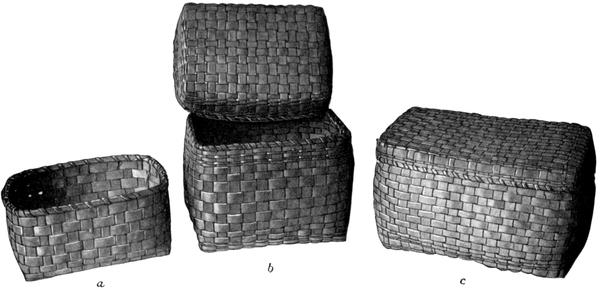
Explanation of Plate II.
Mohegan baskets (a, b, and c painted.)
Plate II.
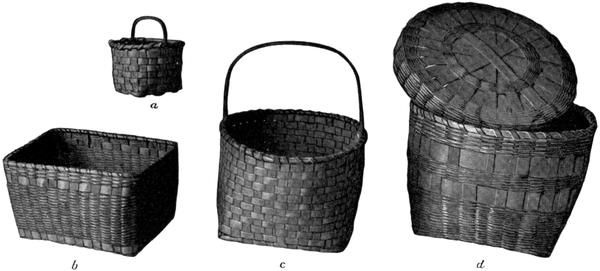
Explanation of Plate III.
Mohegan baskets.
a—Painted.
b—Shows bottom construction.
Plate III.
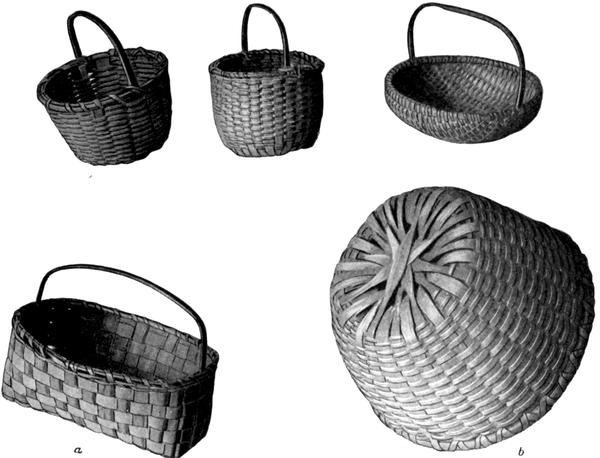
Explanation of Plate IV.
Niantic and Mohegan baskets.
a—Mohegan washing basket.
b—Niantic storage basket made about 1840 by Mrs. Mathews at Black Point
(near Lyme, Conn.)
Plate IV.
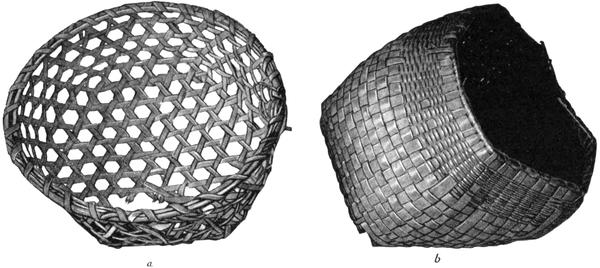
Explanation of Plate V.
Mohegan carrying baskets.
Plate V.
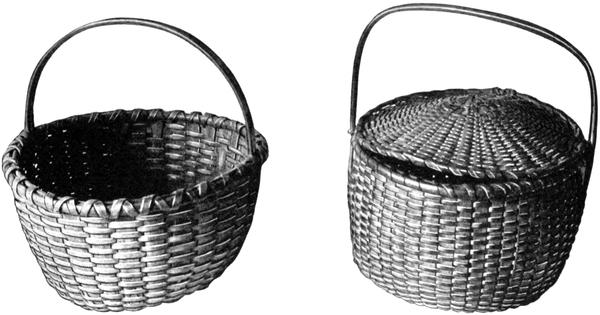
Explanation of Plate VI.
Mohegan baskets, fancy work baskets, and wall pocket.
Plate VI.
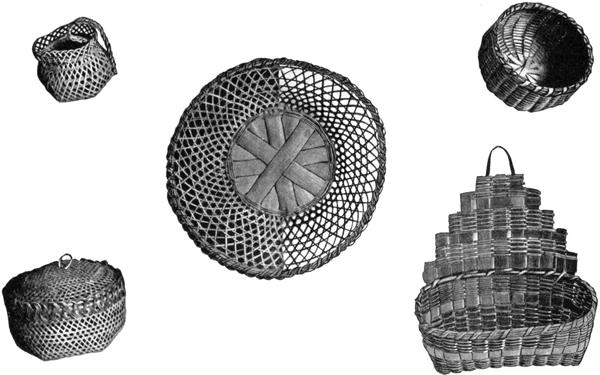
Explanation of Plate VII.
Tunxis baskets. Made by Pually Mossuck, a Tunxis woman from Farmington, Conn., who died about 1890 at Mohegan. Lower left hand basket slightly painted.
Plate VII.
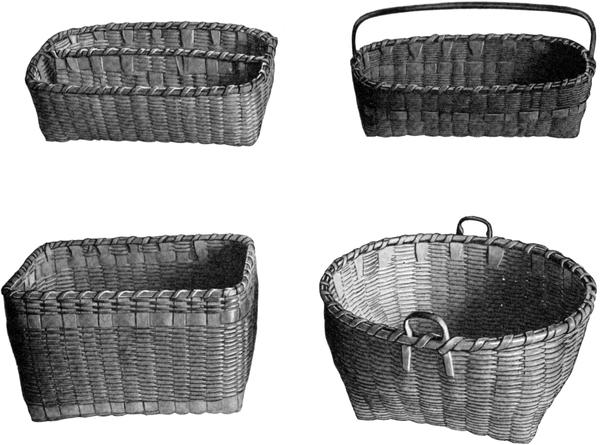
Explanation of Plate VIII.
Scatticook baskets, made by Rachel Mawee, Abigail Mawee, and Viney Carter, who died at Kent, Conn., about 1895.
Plate VIII.
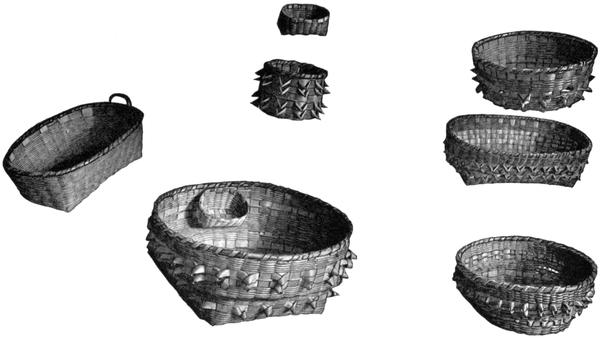
Explanation of Plate IX.
Oneida stamped basket (Heye collection.)
Plate IX.
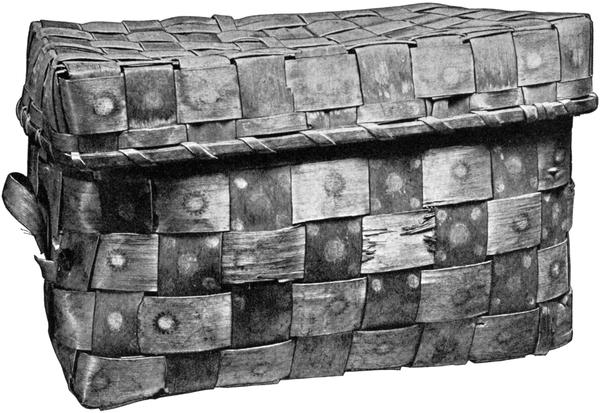
Explanation of Plate X.
Mohegan and Niantic moccasins.
a—Mohegan moccasins.
b—Niantic moccasins from the old reservation at Black Point, near Lyme,
Conn.
Plate X.
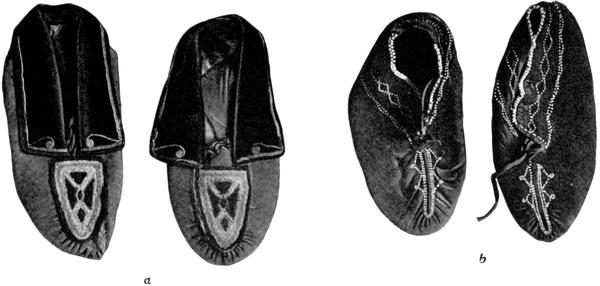
Explanation of Plate XI.
Mohegan and Niantic beaded bags (3 from the Heye collection.)
Plate XI.
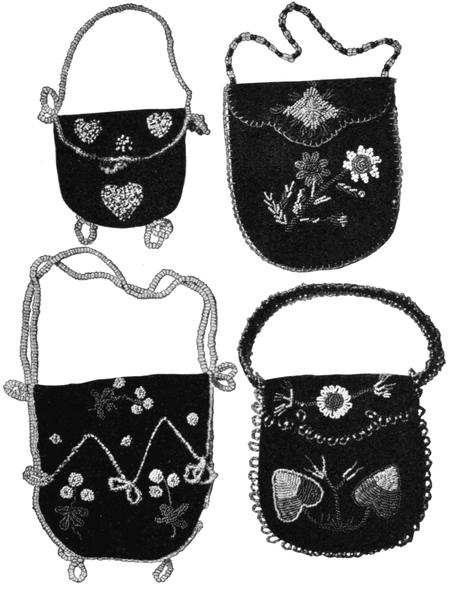
Explanation of Plate XII.
Mohegan corn mortars and stone pestle.
Plate XII.
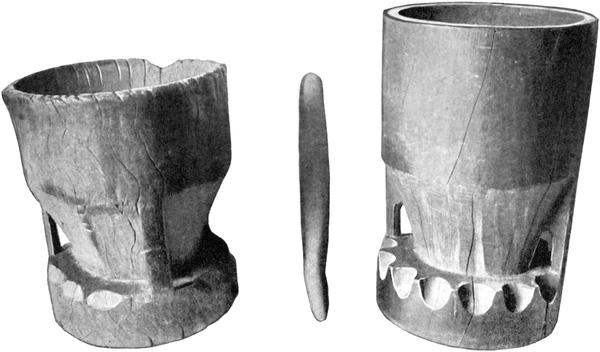
Explanation of Plate XIII.
Mohegan ladles and spoons.
Plate XIII.
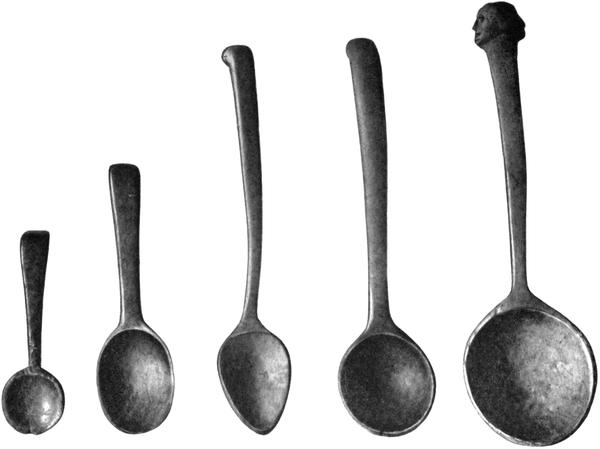
FOOTNOTES:
[1] A few baskets made by an old woman, named Pually Mossuck, of the Tunxis tribe (in the vicinity of Farmington, Conn.) were incidentally obtained. A number of years ago this woman died at Mohegan, the last of her people. This entire collection is now in the possession of Mr. George G. Heye.
[2] In previous papers the writer has already published other ethnologic notes on the Mohegan and Niantic tribes. See Anthropological Papers of the American Museum of Natural History (N.Y.) vol. III, pp. 183–210 (1909), where are also listed papers in collaboration with Prof. J. D. Prince on the Mohegan language.
[3] · indicates that preceding vowel or consonant is long; ‛ indicates breathing following vowel; ´ indicates main stress; ə, like u of English but; ŋ, like ng of English sing; other characters used in transcription of Indian words need no comment.
[4] I am indebted to Mr. Albert Insley for his careful work in deciphering and reproducing the designs on these baskets.
[5] Cf. Roger Williams, A Key into the Language of America, London, 1643 (reprinted by the Narragansett Club), p. 145 and p. 206.
[6] Cf. article in Proceedings of American Philosophical Society, vol. XLII, No. 174 (1903), by J. D. Prince and F. G. Speck; also De Forest, History of the Indians of Connecticut.
[7] ‘Basketry of the Scatticooks and Potatucks,’ Southern Workman, vol. XXXIII, No. 7, 1904, pp. 383–390.
[8] Cf. A. C. Parker, American Anthropologist, N.S., vol. 14, No. 4, 1912, pp. 608–620.
[9] Specimens in the collection of the American Museum of Natural History, New York City. I also learned of the same decorations among the Iroquois at Oshweken, Ontario, and the Mohawks of Deseronto.
Transcriber’s Note:
This e-text is based on the 1915 edition. Punctuation errors have been tacitly removed. The following typographical errors have been corrected:
# p. 3: l. 20/21: “under-one over-one-process” → “under-one-over-one-process”
# Footnote 7: “Scattacook” → “Scatticook”
# Caption for Figure 20: “Satticook” → “Scatticook”
For transliteration of the Mohegan language special pronunciation characters are used in the original text. These characters are specified by the following descriptive terms (cf. Footnote 3):
# ə—schwa: “inverted e”
# ŋ—eng, or engma:“ng”
# ī—“i with macron above”
End of the Project Gutenberg EBook of Decorative Art of Indian Tribes of
Connecticut, by Frank Gouldsmith Speck
*** END OF THIS PROJECT GUTENBERG EBOOK DEC. ART--INDIAN TRIBES--CONNECTICUT ***
***** This file should be named 46578-h.htm or 46578-h.zip *****
This and all associated files of various formats will be found in:
http://www.gutenberg.org/4/6/5/7/46578/
Produced by Reiner Ruf, Greg Bergquist and the Online
Distributed Proofreading Team at http://www.pgdp.net (This
file was produced from images generously made available
by The Internet Archive/American Libraries.)
Updated editions will replace the previous one--the old editions
will be renamed.
Creating the works from public domain print editions means that no
one owns a United States copyright in these works, so the Foundation
(and you!) can copy and distribute it in the United States without
permission and without paying copyright royalties. Special rules,
set forth in the General Terms of Use part of this license, apply to
copying and distributing Project Gutenberg-tm electronic works to
protect the PROJECT GUTENBERG-tm concept and trademark. Project
Gutenberg is a registered trademark, and may not be used if you
charge for the eBooks, unless you receive specific permission. If you
do not charge anything for copies of this eBook, complying with the
rules is very easy. You may use this eBook for nearly any purpose
such as creation of derivative works, reports, performances and
research. They may be modified and printed and given away--you may do
practically ANYTHING with public domain eBooks. Redistribution is
subject to the trademark license, especially commercial
redistribution.
*** START: FULL LICENSE ***
THE FULL PROJECT GUTENBERG LICENSE
PLEASE READ THIS BEFORE YOU DISTRIBUTE OR USE THIS WORK
To protect the Project Gutenberg-tm mission of promoting the free
distribution of electronic works, by using or distributing this work
(or any other work associated in any way with the phrase "Project
Gutenberg"), you agree to comply with all the terms of the Full Project
Gutenberg-tm License available with this file or online at
www.gutenberg.org/license.
Section 1. General Terms of Use and Redistributing Project Gutenberg-tm
electronic works
1.A. By reading or using any part of this Project Gutenberg-tm
electronic work, you indicate that you have read, understand, agree to
and accept all the terms of this license and intellectual property
(trademark/copyright) agreement. If you do not agree to abide by all
the terms of this agreement, you must cease using and return or destroy
all copies of Project Gutenberg-tm electronic works in your possession.
If you paid a fee for obtaining a copy of or access to a Project
Gutenberg-tm electronic work and you do not agree to be bound by the
terms of this agreement, you may obtain a refund from the person or
entity to whom you paid the fee as set forth in paragraph 1.E.8.
1.B. "Project Gutenberg" is a registered trademark. It may only be
used on or associated in any way with an electronic work by people who
agree to be bound by the terms of this agreement. There are a few
things that you can do with most Project Gutenberg-tm electronic works
even without complying with the full terms of this agreement. See
paragraph 1.C below. There are a lot of things you can do with Project
Gutenberg-tm electronic works if you follow the terms of this agreement
and help preserve free future access to Project Gutenberg-tm electronic
works. See paragraph 1.E below.
1.C. The Project Gutenberg Literary Archive Foundation ("the Foundation"
or PGLAF), owns a compilation copyright in the collection of Project
Gutenberg-tm electronic works. Nearly all the individual works in the
collection are in the public domain in the United States. If an
individual work is in the public domain in the United States and you are
located in the United States, we do not claim a right to prevent you from
copying, distributing, performing, displaying or creating derivative
works based on the work as long as all references to Project Gutenberg
are removed. Of course, we hope that you will support the Project
Gutenberg-tm mission of promoting free access to electronic works by
freely sharing Project Gutenberg-tm works in compliance with the terms of
this agreement for keeping the Project Gutenberg-tm name associated with
the work. You can easily comply with the terms of this agreement by
keeping this work in the same format with its attached full Project
Gutenberg-tm License when you share it without charge with others.
1.D. The copyright laws of the place where you are located also govern
what you can do with this work. Copyright laws in most countries are in
a constant state of change. If you are outside the United States, check
the laws of your country in addition to the terms of this agreement
before downloading, copying, displaying, performing, distributing or
creating derivative works based on this work or any other Project
Gutenberg-tm work. The Foundation makes no representations concerning
the copyright status of any work in any country outside the United
States.
1.E. Unless you have removed all references to Project Gutenberg:
1.E.1. The following sentence, with active links to, or other immediate
access to, the full Project Gutenberg-tm License must appear prominently
whenever any copy of a Project Gutenberg-tm work (any work on which the
phrase "Project Gutenberg" appears, or with which the phrase "Project
Gutenberg" is associated) is accessed, displayed, performed, viewed,
copied or distributed:
This eBook is for the use of anyone anywhere at no cost and with
almost no restrictions whatsoever. You may copy it, give it away or
re-use it under the terms of the Project Gutenberg License included
with this eBook or online at www.gutenberg.org
1.E.2. If an individual Project Gutenberg-tm electronic work is derived
from the public domain (does not contain a notice indicating that it is
posted with permission of the copyright holder), the work can be copied
and distributed to anyone in the United States without paying any fees
or charges. If you are redistributing or providing access to a work
with the phrase "Project Gutenberg" associated with or appearing on the
work, you must comply either with the requirements of paragraphs 1.E.1
through 1.E.7 or obtain permission for the use of the work and the
Project Gutenberg-tm trademark as set forth in paragraphs 1.E.8 or
1.E.9.
1.E.3. If an individual Project Gutenberg-tm electronic work is posted
with the permission of the copyright holder, your use and distribution
must comply with both paragraphs 1.E.1 through 1.E.7 and any additional
terms imposed by the copyright holder. Additional terms will be linked
to the Project Gutenberg-tm License for all works posted with the
permission of the copyright holder found at the beginning of this work.
1.E.4. Do not unlink or detach or remove the full Project Gutenberg-tm
License terms from this work, or any files containing a part of this
work or any other work associated with Project Gutenberg-tm.
1.E.5. Do not copy, display, perform, distribute or redistribute this
electronic work, or any part of this electronic work, without
prominently displaying the sentence set forth in paragraph 1.E.1 with
active links or immediate access to the full terms of the Project
Gutenberg-tm License.
1.E.6. You may convert to and distribute this work in any binary,
compressed, marked up, nonproprietary or proprietary form, including any
word processing or hypertext form. However, if you provide access to or
distribute copies of a Project Gutenberg-tm work in a format other than
"Plain Vanilla ASCII" or other format used in the official version
posted on the official Project Gutenberg-tm web site (www.gutenberg.org),
you must, at no additional cost, fee or expense to the user, provide a
copy, a means of exporting a copy, or a means of obtaining a copy upon
request, of the work in its original "Plain Vanilla ASCII" or other
form. Any alternate format must include the full Project Gutenberg-tm
License as specified in paragraph 1.E.1.
1.E.7. Do not charge a fee for access to, viewing, displaying,
performing, copying or distributing any Project Gutenberg-tm works
unless you comply with paragraph 1.E.8 or 1.E.9.
1.E.8. You may charge a reasonable fee for copies of or providing
access to or distributing Project Gutenberg-tm electronic works provided
that
- You pay a royalty fee of 20% of the gross profits you derive from
the use of Project Gutenberg-tm works calculated using the method
you already use to calculate your applicable taxes. The fee is
owed to the owner of the Project Gutenberg-tm trademark, but he
has agreed to donate royalties under this paragraph to the
Project Gutenberg Literary Archive Foundation. Royalty payments
must be paid within 60 days following each date on which you
prepare (or are legally required to prepare) your periodic tax
returns. Royalty payments should be clearly marked as such and
sent to the Project Gutenberg Literary Archive Foundation at the
address specified in Section 4, "Information about donations to
the Project Gutenberg Literary Archive Foundation."
- You provide a full refund of any money paid by a user who notifies
you in writing (or by e-mail) within 30 days of receipt that s/he
does not agree to the terms of the full Project Gutenberg-tm
License. You must require such a user to return or
destroy all copies of the works possessed in a physical medium
and discontinue all use of and all access to other copies of
Project Gutenberg-tm works.
- You provide, in accordance with paragraph 1.F.3, a full refund of any
money paid for a work or a replacement copy, if a defect in the
electronic work is discovered and reported to you within 90 days
of receipt of the work.
- You comply with all other terms of this agreement for free
distribution of Project Gutenberg-tm works.
1.E.9. If you wish to charge a fee or distribute a Project Gutenberg-tm
electronic work or group of works on different terms than are set
forth in this agreement, you must obtain permission in writing from
both the Project Gutenberg Literary Archive Foundation and Michael
Hart, the owner of the Project Gutenberg-tm trademark. Contact the
Foundation as set forth in Section 3 below.
1.F.
1.F.1. Project Gutenberg volunteers and employees expend considerable
effort to identify, do copyright research on, transcribe and proofread
public domain works in creating the Project Gutenberg-tm
collection. Despite these efforts, Project Gutenberg-tm electronic
works, and the medium on which they may be stored, may contain
"Defects," such as, but not limited to, incomplete, inaccurate or
corrupt data, transcription errors, a copyright or other intellectual
property infringement, a defective or damaged disk or other medium, a
computer virus, or computer codes that damage or cannot be read by
your equipment.
1.F.2. LIMITED WARRANTY, DISCLAIMER OF DAMAGES - Except for the "Right
of Replacement or Refund" described in paragraph 1.F.3, the Project
Gutenberg Literary Archive Foundation, the owner of the Project
Gutenberg-tm trademark, and any other party distributing a Project
Gutenberg-tm electronic work under this agreement, disclaim all
liability to you for damages, costs and expenses, including legal
fees. YOU AGREE THAT YOU HAVE NO REMEDIES FOR NEGLIGENCE, STRICT
LIABILITY, BREACH OF WARRANTY OR BREACH OF CONTRACT EXCEPT THOSE
PROVIDED IN PARAGRAPH 1.F.3. YOU AGREE THAT THE FOUNDATION, THE
TRADEMARK OWNER, AND ANY DISTRIBUTOR UNDER THIS AGREEMENT WILL NOT BE
LIABLE TO YOU FOR ACTUAL, DIRECT, INDIRECT, CONSEQUENTIAL, PUNITIVE OR
INCIDENTAL DAMAGES EVEN IF YOU GIVE NOTICE OF THE POSSIBILITY OF SUCH
DAMAGE.
1.F.3. LIMITED RIGHT OF REPLACEMENT OR REFUND - If you discover a
defect in this electronic work within 90 days of receiving it, you can
receive a refund of the money (if any) you paid for it by sending a
written explanation to the person you received the work from. If you
received the work on a physical medium, you must return the medium with
your written explanation. The person or entity that provided you with
the defective work may elect to provide a replacement copy in lieu of a
refund. If you received the work electronically, the person or entity
providing it to you may choose to give you a second opportunity to
receive the work electronically in lieu of a refund. If the second copy
is also defective, you may demand a refund in writing without further
opportunities to fix the problem.
1.F.4. Except for the limited right of replacement or refund set forth
in paragraph 1.F.3, this work is provided to you 'AS-IS', WITH NO OTHER
WARRANTIES OF ANY KIND, EXPRESS OR IMPLIED, INCLUDING BUT NOT LIMITED TO
WARRANTIES OF MERCHANTABILITY OR FITNESS FOR ANY PURPOSE.
1.F.5. Some states do not allow disclaimers of certain implied
warranties or the exclusion or limitation of certain types of damages.
If any disclaimer or limitation set forth in this agreement violates the
law of the state applicable to this agreement, the agreement shall be
interpreted to make the maximum disclaimer or limitation permitted by
the applicable state law. The invalidity or unenforceability of any
provision of this agreement shall not void the remaining provisions.
1.F.6. INDEMNITY - You agree to indemnify and hold the Foundation, the
trademark owner, any agent or employee of the Foundation, anyone
providing copies of Project Gutenberg-tm electronic works in accordance
with this agreement, and any volunteers associated with the production,
promotion and distribution of Project Gutenberg-tm electronic works,
harmless from all liability, costs and expenses, including legal fees,
that arise directly or indirectly from any of the following which you do
or cause to occur: (a) distribution of this or any Project Gutenberg-tm
work, (b) alteration, modification, or additions or deletions to any
Project Gutenberg-tm work, and (c) any Defect you cause.
Section 2. Information about the Mission of Project Gutenberg-tm
Project Gutenberg-tm is synonymous with the free distribution of
electronic works in formats readable by the widest variety of computers
including obsolete, old, middle-aged and new computers. It exists
because of the efforts of hundreds of volunteers and donations from
people in all walks of life.
Volunteers and financial support to provide volunteers with the
assistance they need are critical to reaching Project Gutenberg-tm's
goals and ensuring that the Project Gutenberg-tm collection will
remain freely available for generations to come. In 2001, the Project
Gutenberg Literary Archive Foundation was created to provide a secure
and permanent future for Project Gutenberg-tm and future generations.
To learn more about the Project Gutenberg Literary Archive Foundation
and how your efforts and donations can help, see Sections 3 and 4
and the Foundation information page at www.gutenberg.org
Section 3. Information about the Project Gutenberg Literary Archive
Foundation
The Project Gutenberg Literary Archive Foundation is a non profit
501(c)(3) educational corporation organized under the laws of the
state of Mississippi and granted tax exempt status by the Internal
Revenue Service. The Foundation's EIN or federal tax identification
number is 64-6221541. Contributions to the Project Gutenberg
Literary Archive Foundation are tax deductible to the full extent
permitted by U.S. federal laws and your state's laws.
The Foundation's principal office is located at 4557 Melan Dr. S.
Fairbanks, AK, 99712., but its volunteers and employees are scattered
throughout numerous locations. Its business office is located at 809
North 1500 West, Salt Lake City, UT 84116, (801) 596-1887. Email
contact links and up to date contact information can be found at the
Foundation's web site and official page at www.gutenberg.org/contact
For additional contact information:
Dr. Gregory B. Newby
Chief Executive and Director
gbnewby@pglaf.org
Section 4. Information about Donations to the Project Gutenberg
Literary Archive Foundation
Project Gutenberg-tm depends upon and cannot survive without wide
spread public support and donations to carry out its mission of
increasing the number of public domain and licensed works that can be
freely distributed in machine readable form accessible by the widest
array of equipment including outdated equipment. Many small donations
($1 to $5,000) are particularly important to maintaining tax exempt
status with the IRS.
The Foundation is committed to complying with the laws regulating
charities and charitable donations in all 50 states of the United
States. Compliance requirements are not uniform and it takes a
considerable effort, much paperwork and many fees to meet and keep up
with these requirements. We do not solicit donations in locations
where we have not received written confirmation of compliance. To
SEND DONATIONS or determine the status of compliance for any
particular state visit www.gutenberg.org/donate
While we cannot and do not solicit contributions from states where we
have not met the solicitation requirements, we know of no prohibition
against accepting unsolicited donations from donors in such states who
approach us with offers to donate.
International donations are gratefully accepted, but we cannot make
any statements concerning tax treatment of donations received from
outside the United States. U.S. laws alone swamp our small staff.
Please check the Project Gutenberg Web pages for current donation
methods and addresses. Donations are accepted in a number of other
ways including checks, online payments and credit card donations.
To donate, please visit: www.gutenberg.org/donate
Section 5. General Information About Project Gutenberg-tm electronic
works.
Professor Michael S. Hart was the originator of the Project Gutenberg-tm
concept of a library of electronic works that could be freely shared
with anyone. For forty years, he produced and distributed Project
Gutenberg-tm eBooks with only a loose network of volunteer support.
Project Gutenberg-tm eBooks are often created from several printed
editions, all of which are confirmed as Public Domain in the U.S.
unless a copyright notice is included. Thus, we do not necessarily
keep eBooks in compliance with any particular paper edition.
Most people start at our Web site which has the main PG search facility:
www.gutenberg.org
This Web site includes information about Project Gutenberg-tm,
including how to make donations to the Project Gutenberg Literary
Archive Foundation, how to help produce our new eBooks, and how to
subscribe to our email newsletter to hear about new eBooks.